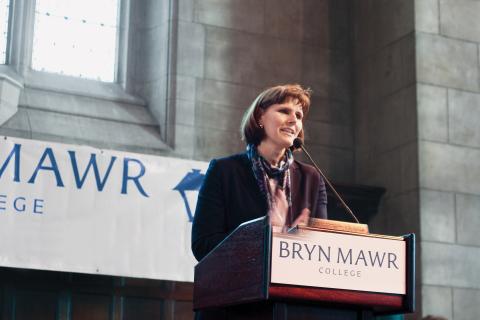The Bubble and The Network
Reflecting on the continued importance of women's colleges.

Dear Friends:
We sometimes joke about the “Bryn Mawr bubble” of norms and expectations that are created by working (and in the case of students, living) in this scholarly community. It is all too easy for anyone with a busy and engaging life to find oneself in a bubble and not connecting often enough with peers and friends who have different experiences and perspectives. I certainly fall prey to that habit myself. But having recently returned from a number of professional gatherings, I want to advocate for the value of setting aside time for peer networks, both for ourselves and for the organizations and groups in which we work.
I am fortunate to have many professional peer groups. Many are college groups with which Bryn Mawr shares institutional characteristics: the Sisters, the Women’s College Coalition, the Annapolis Group of liberal arts colleges, the Pennsylvania Consortium for the Liberal Arts, and the Consortium on Higher Education Financing (three dozen highly selective universities and colleges). The opportunity to learn best practices, to deepen understanding of how our kinds of institutions work, and to hear about how others respond to challenges is invaluable. I feel particularly lucky to have the close colleagueship of Haverford President Kim Benston and the benefit of his deep understanding of Bryn Mawr and the Bi-College relationship.
Increasingly, I also value getting to know those who lead institutions different from Bryn Mawr. These peers have given me new perspectives and tools to bring to working with the Bryn Mawr community. I have become conscious, for example, that while I am likely to approach an issue by considering how faculty will respond (perhaps not surprising after more than 25 years as a professor), many colleagues begin by thinking from the point of view of admissions or students or alumnae/i or donors. These conversations also offer opportunities to learn from institutions that have addressed problems that may well come our way, such as protests against outside speakers, and to do some advance planning.
Leaving the Bryn Mawr bubble allows me to see anew the continued importance of women’s colleges in educating students who will advance gender equity. In networks of college leaders, I observe that many men in the room still assume the right to speak first and often, and to credit ideas to a man who has spoken more loudly than to the woman who voiced the same idea. Many of my female presidential peers do not countenance this dynamic, of course, but an environment that encourages women to claim their voices clearly has an important role to play in preparing students for the organizations in which they will work.
The reality of my networks, and likely of yours as well, is that I am reminded of shared identity and valuable distinctiveness. Bryn Mawr belongs to several communities of residential, liberal arts-focused institutions with which we share fundamental values and aspirations. This is a resource of solidarity and inspiration. But working with my peers also sharpens my awareness that Bryn Mawr is, indeed, a special place. We are mission-driven by historical commitments to academic excellence, opportunity for women, and a faculty of teacher-scholars. We are beneficiaries of alumnae/i generosity and of thoughtful stewardship of our resources, resulting in a financial stability that many envy. And we have attracted generations of smart, independent-minded women who hold themselves and the College to the highest standards. I am grateful to call Bryn Mawr my professional home.
Sincerely,
Kim Cassidy
President
Published on: 09/24/2018

